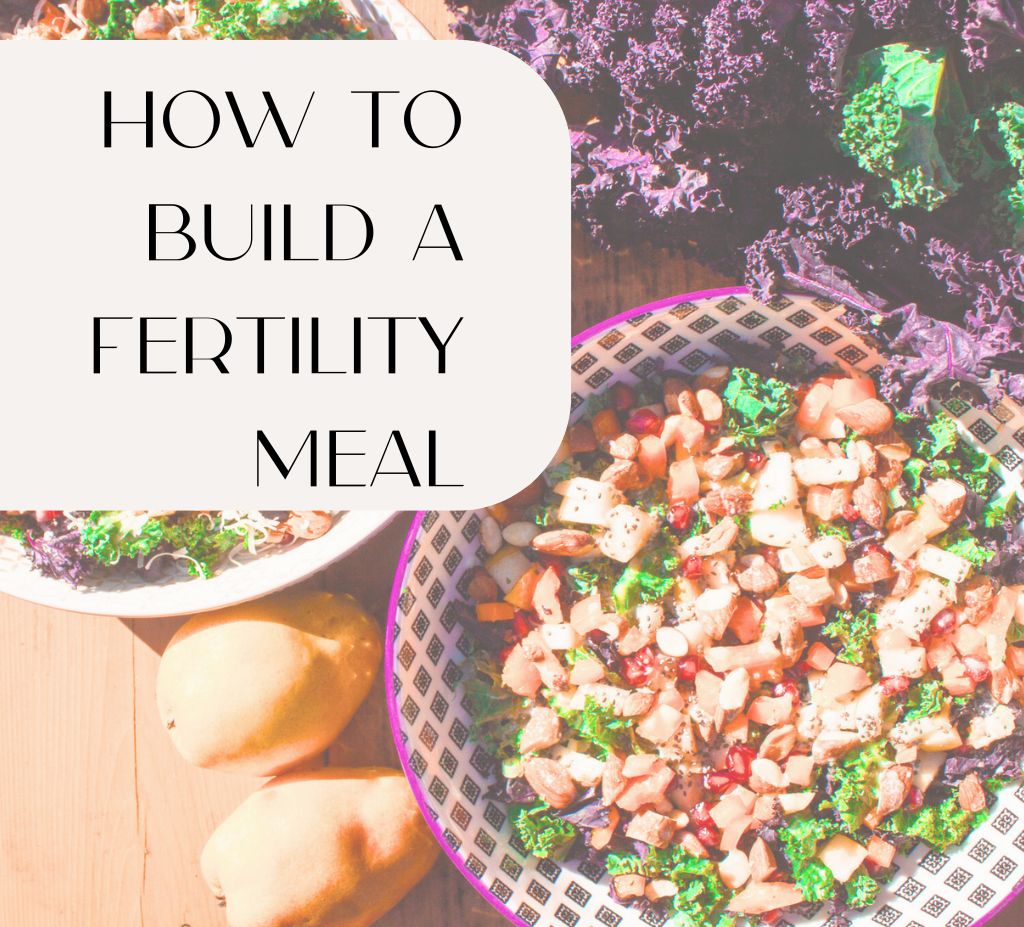how to build a fertility meal
What we eat has an impact on our health and goal outcomes. Because of this, I work hard to get you action-focused plans that will help you each and every day. This is why I put together this easy-to-follow guide on how to build a fertility meal. Further to that, this way of allows you flexibility in your choices and variety in your weeks so you don’t get stuck in a rut with daily meal prep. You can feel good about putting your meals together with foods you enjoy knowing that this combination if a winning one!
On that, let these 4 simple steps guide you in establishing your go-to routine for breakfast, lunch, and dinner. Refer to this guide often, as I have listed my favorite proteins, fats and carbs below.
Here are some great fertility-focused recipes you can try too!

Step 1: Start with colourful vegetables
Start the meal planning process with vegetables as the first thing. We tend to think of protein first and let the veggies be an afterthought. Because of that, veggies get consumed in smaller quantities. In order to eat them in larger amounts, think of them first. Be sure to include 2 or 3 different colourful veggies or frutis, at each meal. Also, you can even try a fruit or vegetable that you haven’t tried before. That makes for a few more exciting flavours.
To help you, I have included a list of colourful fruit and vegetables to get your started.
- Red: berries, peppers, tomatoes, beets, watermelon radishes
- Orange: carrots, oranges, squash, sweet potatoes, persimmon, papaya
- Purple: eggplant, blueberries, blackberries, purple yam, figs
- White: cauliflower, turnip, parsnip, onion, garlic, kohlrabi, fennel, Jerusalem artichokes
- Green: dark greens, okra, fiddleheads, broccoflower, kale, Brussel sprouts, bok choy
- Yellow: zucchini, pineapple, pears, plantain, grapes, guava, mango, peppers, beans, ground cherries
To further this, I want you know that different colours means you are eating a different variety of antioxidants! And antioxidants means anti-inflammation. That is a strong focus when it comes to fertility meals.

Step 2: Add a lean protein
The next step is to add a lean protein to your fertility meal. Firstly, protein is critical to maintaining cellular integrity, which means, the ovum or sperm can develop normally. Secondly, protein is also required to support of the regulation and flow of the hormone system in both males and females. Therefore, the type of protein you eat is important in your meals.
I have provided you below with some of my favourite protein sources that you can add to your meals to help support your fertility health!
- Beans & lentils
- Poultry
- Salmon, tuna, herring or Atlantic Mackerel
- Shrimp
- Tofu & Tempeh
- Greek Yogurt
- Mussels/Clams/Oysters
- Eggs
Moreover, I encourage you to try to replace some animal-based proteins with plant-based proteins. When building your fertility meal, try swapping them at least once a week. This is because swapping out some animal protein for plant protein is supported in the science. Commonly, these are lentils, beans, chickpeas, tofu and tempeh.
See here for some great plant-based and here for great fish-based recipes.

Step 3: Add a whole grain
Thirdly, to balance your meal, add whole grains. More importantly, using whole grains adds a variety of nutrients and satisfaction to your meals that you can’t get from other foods. For instance, whole grains that I enjoy include:
Therefore, before you end your meals with protein and veggies, add some whole grains to increase your satiety, your overall health, and your nutrient profile.

Step 4: Include healthy fats
Lastly, healthy fats are key! They are key to adequate hormone health, ovulation, sperm health, and more. In other words, these work to increase the absorption of the nutrients in your entire meal. When it comes to fertility studies, the most-studied fat is extra virgin Olive oil. This is because it is full of monounsaturated fats that fight inflammation and promote healthy hormones and ovulation.
Other healthy fats include:
- Avocados
- Olives
- Nut butters
- Nuts
- Seeds
Use these as an add-on to your meals and snacks. You can top your soups, salads, dips, and veggies with any of these healthy fats.

Fertility Meal Summary
Use these four steps to build meals that support your fertility path.
And let me be clear, you don’t have to do this every single time you eat! There should never be times when you eat and you feel regret because you didn’t eat a certain way. These steps are simply a guide to help you build your meals when you are ready and feeling up for it. I’m not saying for you to do this every single time you think about eating a meal or a snack but I am giving you recommendations and guidelines so that when you are ready to build a meal, this guide is here for you. Use this easy-step guide often, for both you and your partner.





Leave a Reply
You must be logged in to post a comment.